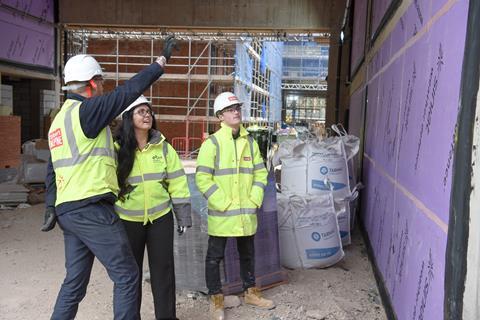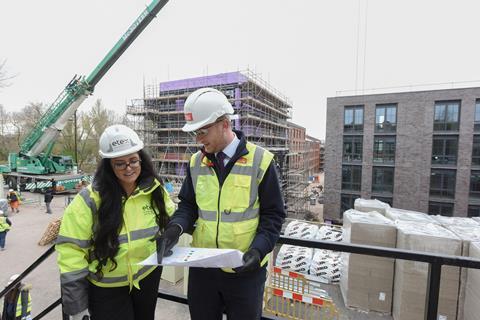The construction industry is facing an abundance of changes to rules and regulations – early engagement and supply chain collaboration is the only way to navigate these changes, writes Nigel Morrey, technical director at Siniat
The industry is changing at a faster rate than we have ever seen before.
There is a tremendous drive for competency, productivity and transparency which is all underpinned by major changes to legislation, regulations, and working practices.
To navigate this, collaboration is key.

While the word ‘collaboration’ has been thrown around a lot over the past few years, we are now starting to see it in practice. New industry groups have begun to form and are pushing for increased competencies across the supply chain.
The development of these forums provides a space in which concerns, issues, or grey areas, can be discussed and addressed. But on top of this, these visible collaborative efforts demonstrate how we can work together to take control of the future, rather than waiting for the future to happen to us.
With the biggest set of regulation changes to impact us in over a decade – including huge changes to the Building Safety Act (BSA) having come into force only last month – this collaboration is critical. Cross-party engagement both on an industry scale, and a project scale, is the only way to identify and address issues or anomalies before safe construction can begin.
Communication is key
Concerns around liability have long been a widespread issue in the sector and with the BSA enforcing the requirement for an ‘accountable person,’ the concerns have been magnified.
However, being accountable shouldn’t be news to us. We are all accountable - we always have been.
Designing, constructing and supplying for buildings that will perform well and stand the test of time should have always been at the top of the agenda. To effectively do this, we should be communicating and putting detailed design strategies in place – long before construction – if we want work to proceed smoothly, and safely.

As part of this, the early provision of performance data should be a priority across all projects. In fact, the BSA outlines the requirement to provide a ‘Golden Thread’ of information on a building, and the materials used within it, that is easily accessible from conception and right through to the building’s end of life.
To support with this provision, in recent years, we have invested heavily in testing and the acquisition of readily available third party classification reports for our entire portfolio of systems, which are now available as standard as part of our project packs. This helps us to ensure that from our initial interactions with partners, we are designing with performance and safety in mind.
In addition to this, Siniat partition systems with 30, 60, 90 and 120 minutes of fire resistance have now been verified against the CCPI, which was developed by the Construction Products Association’s (CPA) Marketing Integrity Group. The Code was then handed over to the not-for-profit Construction Product Information Ltd to administer the Code and verification process and provide more confidence that the product information is clear, accurate, accessible, up-to-date and unambiguous. The four product sets now verified cover all of the partition systems published on Siniat’s website and in its Drywall Manual.
Needless to say, however, providing a golden thread of information is no small task. There is currently no set outline, or template, for the industry to adopt and use. This means that the only way to ensure the provision of the data required is to engage early in a project, determine which products will be used and where, and acquire the information in the initial design stages.
Putting it into practice
Early engagement between the lead designer, main contractor and manufacturer is critical not only to ensure compliance but to ensure the smooth running of a project.
Oftentimes, construction will go ahead only for issues to be found later down the line. When it comes to drylining, for instance, according to the Finishes and Interiors Sector (FIS), 17% of rework could have been avoided if the supply chain had engaged earlier and created a detailed plan from the outset.
This means that engaging early not only helps to ensure a building will be safe but enables parties to find solutions at the start of the project, rather than rectifying problems later, which saves time and money, too.

At Siniat, early design engagement is one of our key values. A recent example of this was our work with Sir Robert McAlpine on one of the main contractor’s latest projects, Hockley Mills, which is a mixed-use development in the heart of the Jewellery Quarter in Birmingham’s City Centre.
In the early stages of the project, we engaged with Sir Robert McAlpine, the architect Glancy Nicholls, and subcontractor Taylor Hart to develop a detailed plan of how we would approach the design and installation.

In addition to the project being a high rise residential build, one of the challenges was its location adjacent to a train station, which meant that the project required enhanced acoustic qualities and that all materials required bespoke detailing to dissipate the noise throughout the building and avoid disruption to residents.
We worked with the architect and subcontractor in the early stages to devise a bespoke solution that utilised Siniat Thruwall® and would ensure party walls could achieve a 5dB improvement on the minimum requirement of Building Regulations Approved Document E.
This early engagement also enabled us to develop a detailed plan with subcontractor, Taylor Hart, in which our technical team – alongside our colleagues at other Etex brands - were able to support with installation details including joints, fire stopping and detailing around apertures and services.
Due to the in-depth support from our technical team and the provision up of robust data, the installation ran smoothly and upon completion, the scheme will be home to 395 residents and their families as well as providing space for retail, leisure and offices.
Taking control of our future
While it may sound cliché, working together is the only way that we will successfully navigate the complexities that face us.
Early engagement not only provides an opportunity to identify potential issues and find solutions, but also allows different parties to raise a hand where they are unsure, educate each other, and begin to overcome some of the current challenges.
This collaboration not only ensures that buildings perform well, and are safe – but that our competencies increase, too.
By truly embracing opportunities to collaborate, on both a large and small scale, we will not only enhance the performance of our people and our buildings but we’ll be taking control of our future, too.
To view collaboration in practice, watch our Hockley Mills case study below.
Siniat recently launched its MySiniat portal which allows architects and specifiers to easily access technical information for any project, from anywhere.
No matter what the project, Siniat provides tailored technical support, whether that’s through adapting to challenges that are specific to location or to ensure that projects are meet up to date legislation.
For more information, visit: https://www.siniat.co.uk/en-gb/uk/mysiniat/




























